Types of Cheese / Category of Cheese – Hotels | Resorts
Cheese is one of the most versatile and beloved foods in the world. There are hundreds of different types of cheese, each with its own unique taste, texture, and aroma. But all cheeses can be categorized into a few different categories based on how they are made and what ingredients are used.
One of the most basic ways to categorize cheese is by its texture. Soft cheeses like brie and camembert have a creamy, spreadable texture, while hard cheeses like cheddar and parmesan are firm and crumbly. Semi-soft cheeses like gouda and havarti fall somewhere in between.
Another way to categorize cheese is by its flavor. Some cheeses are mild and creamy, while others are sharp and tangy. Blue cheeses like gorgonzola and roquefort have a distinct, pungent flavor, while fresh cheeses like ricotta and mozzarella have a mild, milky taste.
Cheeses can also be categorized by how they are made. Some cheeses are made from cow’s milk, while others are made from goat’s milk or sheep’s milk. Some cheeses are aged for months or even years, while others are fresh and meant to be eaten right away.
The cheese is comprised of three main components Water, Fat, and ProteinProtein - Are Extremely complex combinations of amino acids which occur naturally in different food .... And is produced by separating milk solids by curdling, this causes the proteins in the milk to coagulate. CurdlingCurdling (Break) - When liquid such as milk. or a mixture such as a sauce loses its ability to hold ... is normally done by adding selected bacteria or enzymes to the milk.
The curds from the above process are then drained, processed, and aged in multiple ways. There are many varieties of cheese depending upon the various cheese processing techniques and the type of milk used for the process.
The type of cheese or category of cheese is determined by a) The Method of the Crudling process. b) The Type of Milk used (Cow’s Milk, goat’s Milk, etc.) c) The way curds are cut d) The way curds are drained. e) The way curds are pressed. f) The condition of aging or ripening the cheese.
The below list shows the Types of Cheese or Categories of Cheese:
1) Unripened Cheese:
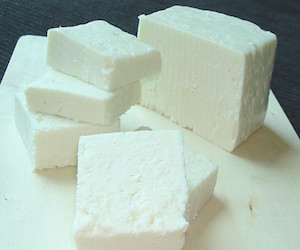
Unripened cheese, also known as fresh cheese, is a type of cheese that is made and sold without ageing. This means that the cheese is consumed shortly after it is made, typically within a few days or weeks.
Some examples of unripened cheese include ricotta, feta, cream cheese, and cottage cheese. These cheeses are often used in dishes such as salads, dips, and spreads.
One of the benefits of unripened cheese is that it is lower in fat and calories compared to aged cheeses. It is also a good source of protein, calcium, and other essential nutrients.
However, because unripened cheese is not aged, it has a higher moisture content and is more perishable. It is important to store unripened cheese properly in the refrigerator and consume it before the expiration date to avoid spoilage.
Overall, unripened cheese is a versatile and healthy addition to any diet. With its mild flavour and creamy texture, it can be enjoyed in a variety of dishes and recipes.
These are freshly made cheese which is soft and white. Examples of unripened cheese are Cottage cheese, Ricotta, Mozzarella, etc.
2) Semi-soft Cheese
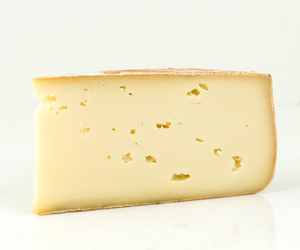
Semi-soft cheeses are a diverse category of cheeses that fall between the firmness of hard cheeses and the softness of fresh, unripened cheeses. These cheeses typically have a higher moisture content than hard cheeses, giving them a softer, more pliable texture. The flavor profiles of semi-soft cheeses can vary widely, ranging from mild and buttery to more robust and tangy.
Here are some examples of semi-soft cheeses:
- Cheddar: While there are aged and sharp cheddars that are quite firm, younger cheddars can fall into the semi-soft category. They have a smoother texture and a milder flavor compared to their aged counterparts.
- Gouda: This Dutch cheese comes in various forms, and younger Goudas tend to be semi-soft. They have a creamy texture and a mild, slightly sweet flavor.
- Havarti: Originating from Denmark, Havarti is a semi-soft cheese with a buttery taste and a smooth, creamy texture.
- Fontina: A semi-soft Italian cheese that is known for its earthy, nutty flavor. It melts well, making it a popular choice for fondues and creamy sauces.
- Edam: Another Dutch cheese, Edam, is traditionally made in a ball shape. It has a mild, nutty flavor and a firm yet slightly elastic texture.
- Monterey Jack: This American cheese is often classified as semi-soft. It has a mild flavor and melts well, making it suitable for a variety of dishes.
Semi-soft cheeses are versatile and can be enjoyed on their own, melted in sandwiches or casseroles, and used in various culinary applications. The texture and flavor of these cheeses make them appealing to a wide range of palates.
Such type of cheese is more developed than the unripened ones. But these also have a soft texture. Examples of semi-soft cheese are Muster, Fontina, Bel paise, etc.
3) Soft Ripened Cheese
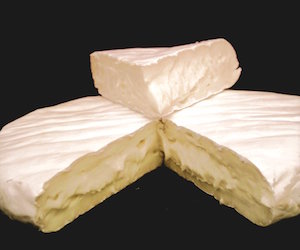
Soft-ripened cheeses, also known as bloomy rind or white rind cheeses, are a distinctive category of cheeses characterized by their creamy texture, rich flavors, and often a velvety, edible rind. These cheeses undergo a ripening process where beneficial molds, such as Penicillium candidum, are introduced to the surface, creating a soft, fluffy layer on the outside. The inside of the cheese becomes creamy and luscious as it ripens.
Here are some examples of popular soft-ripened cheeses:
- BrieLarge flat round soft cheese from France; one of the most popular cheeses.: Originating from France, Brie is a well-known soft-ripened cheese with a creamy interior and a soft, edible white rind. It has a mild, buttery flavor.
- CamembertSoft French cheese; 12 cm diameter by 2.5 cm high.one of the most popular cheeses.: Similar to Brie, Camembert is a French cheese that features a creamy interior and a bloomy rind. It has a slightly stronger flavor than Brie.
- Triple Crème: These are not specific cheeses but rather a category that includes cheeses with a high butterfat content, resulting in an extra-creamy texture. Examples include Brillat-Savarin and Explorateur.
- Chaource: A French cheese with a bloomy rind and a creamy interior. It has a rich, tangy flavor and is made from cow’s milk.
- Saint-André: This triple crème cheese from France is incredibly creamy and luxurious, with a high butterfat content. It has a mild and sweet flavor.
- Taleggio: An Italian soft-ripened cheese with a strong aroma and a tangy, fruity flavor. It has a thin, washed rind.
- Coulommiers: Another French cheese similar to Brie and Camembert but typically larger in size. It has a creamy texture and mild flavor.
Soft-ripened cheeses are often served at room temperature to allow the interior to soften, making them spreadable and enhancing their flavors. These cheeses pair well with fruits, nuts, and crusty bread, and they are a popular choice for cheese boards and elegant appetizers.
These are generally ripened from the outside toward the center. As this type of cheese ages, it becomes more softened and when fully aged this cheese has a runny consistency.
Example of soft-ripened cheese is Brie, Camembert, DoubleA guest room assigned to two people. In beverage operations; a drink prepared with twice the standar... creme cheese, etc.
4) Hard Ripened Cheese
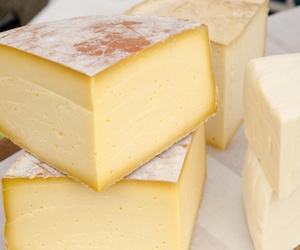
Hard-ripened cheeses are cheeses that have undergone an extended aging process, resulting in a firm texture and often a more concentrated, intense flavor. The aging process involves the development of complex flavors and textures as the cheese loses moisture and undergoes chemical changes. Here are some examples of hard-ripened cheeses:
- ParmesanVery hard cheese with a sharp flavour; nearly always used grated for sprinkling over pasta dishes. (Parmigiano-Reggiano): Originating from Italy, Parmesan is a hard, granular cheese that is aged for an extended period. It has a sharp, savory flavor and a crumbly texture. Parmesan is often grated and used as a topping for pasta dishes.
- Grana Padano: Another Italian cheese similar to Parmesan, Grana Padano has a granular texture and a nutty, slightly sweet flavor. It is also commonly grated and used in various dishes.
- Pecorino Romano: Made from sheep’s milk, Pecorino Romano is a hard and salty Italian cheese. It is often grated over pasta or soups for added flavor.
- Gruyère: A Swiss cheese known for its firm texture and sweet, nutty flavor. Gruyère melts well, making it a popular choice for fondues and gratins.
- Manchego: A Spanish cheese made from sheep’s milk, Manchego has a firm texture and a nutty, buttery flavor. It is often served in slices or grated.
- Comté: A French cheese with a firm texture and a complex, fruity flavor. Comté is aged for different lengths, ranging from a few months to several years.
- Cheddar (Aged): While younger cheddars are semi-soft, aged cheddars become firmer and develop a more intense flavor. Aged cheddar can have a sharp, tangy taste.
Hard-ripened cheeses are versatile and can be enjoyed on their own or incorporated into a variety of dishes. They are often used for grating, shredding, or slicing, and their concentrated flavors make them suitable for both cooking and snacking.
Hard-ripened cheese always has a firm texture with flavors varying from mild to sharp depending on their age.
Example of hard-ripened cheese is Cheddar, Colby, Domestic Swiss, Monterey Jack, etc.
5) Hard Grating Cheese
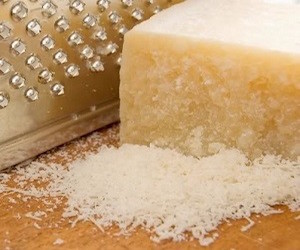
Hard grating cheeses are cheeses that are specifically well-suited for grating, and they often have a firm texture and intense flavors. Grating cheeses are commonly used to add a burst of flavor and a textured finish to various dishes. Here are some examples of hard grating cheeses:
- Parmesan (Parmigiano-Reggiano): Parmesan is perhaps the most famous grating cheese. It has a granular texture, a sharp, nutty flavor, and is widely used in Italian cuisine. Parmesan is often grated over pasta, salads, soups, and various other dishes.
- Grana Padano: Similar to Parmesan, Grana Padano is an Italian cheese with a grainy texture and a slightly milder flavor. It is often used for grating and topping dishes.
- Pecorino Romano: Made from sheep’s milk, Pecorino Romano is a hard and salty cheese. It has a robust flavor, making it an excellent choice for grating over pasta dishes, soups, and salads.
- Asiago (Aged): Asiago cheese comes in different varieties, and the aged version is firm and suitable for grating. It has a rich, nutty flavor and is often used in pasta dishes and salads.
- Gruyère: While Gruyère is commonly known for melting well, aged Gruyère has a firm texture that makes it suitable for grating. It adds a distinctive nutty flavor to dishes.
- Parmesan-Reggianito: Hailing from Argentina, Parmesan-Reggianito is an Argentine cheese modeled after Parmesan. It has a firm texture and a sharp flavor, making it a good grating cheese.
- Fiore Sardo: An Italian cheese made from sheep’s milk, Fiore Sardo is firm, slightly crumbly, and has a distinct smoky flavor. It is often grated over pasta dishes.
These cheeses are not only flavorful but also have a dry and crumbly texture that makes them ideal for grating. Grating cheeses are versatile and can enhance the taste and texture of a wide range of dishes.
These types of cheese are aged for a long period, normally up to 2 years. They have a strong flavor due to this long aging process. Such a type of cheese is very hard to cut and is normally sold after grating.
Example of hard-grating cheese is Parmesan, Parmigiano Reggiano, Dry Jack, Pecorino Romano, etc.
6) Goat Cheese
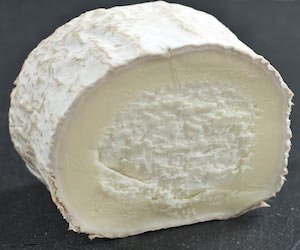
Goat cheese, also known as chèvre (French for goat), is a type of cheese made from goat’s milk. It comes in various forms, textures, and flavors, ranging from fresh and mild to aged and pungent. Goat cheese has become increasingly popular for its distinctive taste and versatility in culinary applications. Here are some common types of goat cheese:
- Fresh Goat Cheese (Chèvre): This is a young, unaged goat cheese with a creamy and spreadable texture. It is often sold in logs, crumbles, or rounds and can be flavored with herbs, spices, or other ingredients.
- Bûcheron: This is a semi-aged goat cheese that is shaped like a log. It has a firmer texture closer to the rind and a creamy, gooey interior.
- Crottin de Chavignol: A small, disc-shaped goat cheese that originates from France. It can be consumed fresh when young or aged for a more intense flavor.
- Cabra al Romero: A Spanish goat cheese coated with rosemary. It has a mild, herbal flavor and a semi-firm texture.
- Garrotxa: Hailing from Catalonia, Spain, Garrotxa is a semi-hard goat cheese with a natural rind. It has a nutty, earthy flavor and a slightly crumbly texture.
- Pantysgawn: A Welsh goat cheese with a creamy texture and often flavored with herbs or spices.
- Caprino: An Italian goat cheese that can be fresh or aged. Fresh Caprino has a mild, tangy flavor, while aged versions develop a more complex taste.
- Montrachet: This is a fresh, young goat cheese that is mild and slightly tangy. It is often used in salads, appetizers, and desserts.
Goat cheese is versatile and can be used in a variety of dishes. It pairs well with fruits, honey, and nuts, making it a popular choice for salads and appetizers. Additionally, goat cheese can be spread on bread, crackers, or used in both sweet and savory recipes. The flavor and texture of goat cheese can vary depending on its age, production methods, and added ingredients.
As per the name, these cheeses are made from goat’s mild and produced in many varieties. It is most popular in France where it is called ‘chevre’.
Unaged goat cheese is very popular and has a white color, mild flavor, and a dry texture to it.
Example of chevre is Montrachet, Bucheron, Chablis, Crottin de Chavignol, etc.
7) Blue Veined Cheese
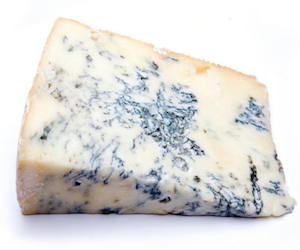
Blue-veined cheeses, also known as blue cheese or bleu cheese, are a distinctive category of cheeses characterized by the presence of blue or greenish veins running through the cheese. These veins are formed by the introduction of specific mold cultures, such as Penicillium roqueforti or Penicillium glaucum, during the cheese-making process. The mold spores grow and develop in the cheese, creating characteristic pockets of flavor and a tangy, sharp taste. Here are some examples of popular blue-veined cheeses:
- Roquefort: A French blue cheese made from sheep’s milk. Roquefort is creamy, tangy, and has a distinct flavor profile. It is aged in natural caves, contributing to its unique characteristics.
- Gorgonzola: An Italian blue cheese made from cow’s milk. Gorgonzola can be mild or strong, depending on its age. It has a crumbly texture and a bold, savory flavor.
- Stilton: An English blue cheese that can be made from cow’s, sheep’s, or goat’s milk. Stilton has a rich and creamy texture, with a mellow and slightly sweet flavor.
- Danish Blue: A cow’s milk blue cheese from Denmark, it is known for its smooth and creamy texture. It has a milder flavor compared to some other blue cheeses.
- Cabrales: A Spanish blue cheese made from a blend of cow, sheep, and goat milk. Cabrales has a strong, robust flavor with a crumbly texture.
- Bleu d’Auvergne: A French blue cheese made from cow’s milk. It has a creamy texture and a strong, tangy taste. The blue veining is evenly distributed throughout the cheese.
- Maytag Blue: An American blue cheese made from cow’s milk. It has a crumbly texture and a bold, tangy flavor.
- Cambozola: This is a German blue cheese that combines the creamy texture of Camembert with the blue veins of Gorgonzola. It has a milder flavor compared to some traditional blue cheeses.
Blue-veined cheeses are often enjoyed on their own or crumbled over salads, added to sauces, or paired with fruits and nuts. The distinct flavor and creamy texture make them a unique and beloved category in the world of cheese.
Blue-veined cheese is ripened with cultures of the mold Penicillium. Such cheese is characterized by green, blue, or black veins or spots of mold throughout the cheese.










